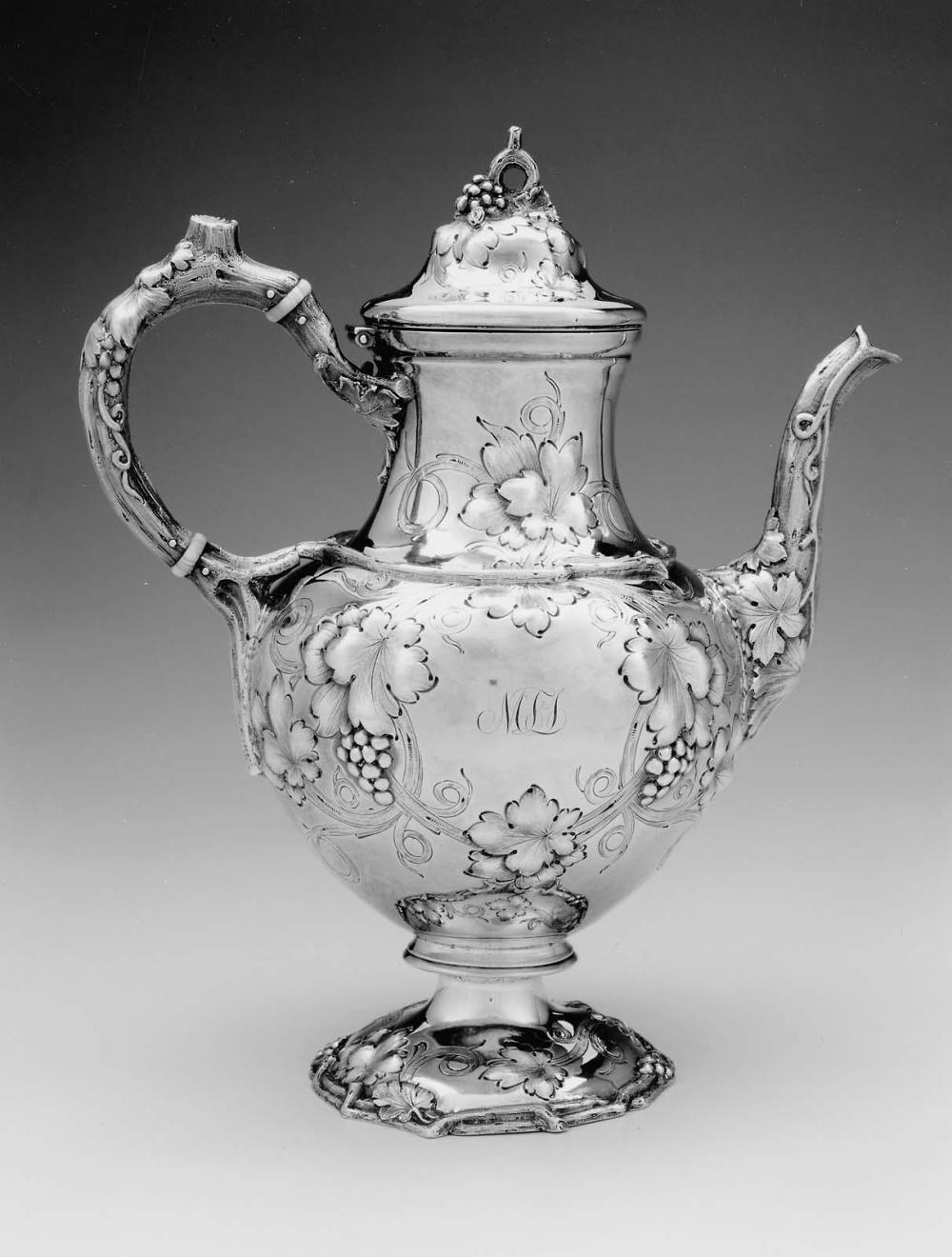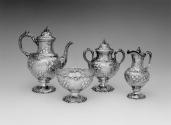Advanced Search
Four-piece tea service
William Gale & Son (active 1850–1858 and 1863–1866)
William Gale, Sr. (American, 1799–1864)
William Gale, Jr. (American, 1825 or 1831–1885)
William Gale, Sr. (American, 1799–1864)
William Gale, Jr. (American, 1825 or 1831–1885)
1852
Object Place: New York, New York, United States
Medium/Technique
Silver
Dimensions
Teapot: 29.7 x 26.5 x 16 cm (11 11/16 x 10 7/16 x 6 5/16 in.)
Sugar bowl: 24.4 x 20 x 14.3 cm (9 5/8 x 7 7/8 x 5 5/8 in.)
Covered creampot: 22.2 x 13.5 x 11.4 cm (8 3/4 x 5 5/16 x 4 1/2 in.)
Waste bowl: 12 x 16 cm, 0.46 kg (4 3/4 x 6 5/16 in., 1.01 lb.)
Sugar bowl: 24.4 x 20 x 14.3 cm (9 5/8 x 7 7/8 x 5 5/8 in.)
Covered creampot: 22.2 x 13.5 x 11.4 cm (8 3/4 x 5 5/16 x 4 1/2 in.)
Waste bowl: 12 x 16 cm, 0.46 kg (4 3/4 x 6 5/16 in., 1.01 lb.)
Credit Line
Gift of Mrs. James O. Murray
Accession Number65.1195-1198
NOT ON VIEW
CollectionsAmericas
ClassificationsSilver hollowware
This tea service was produced two years after William Gale Sr. made his son a partner in the firm, which became a popular source for hollowware such as this matching tea service. By midcentury the firm’s employees numbered seventy-five. Presented as a wedding gift, the service was decorated in the fashionable Rococo-revival style. William Gale & Son apparently copied its scheme of rusticated grapevines that serve to cover joints and form handles from the design of a teakettle on stand made in 1850 by Edward Moore. A stylish and costly service, elaborately repousséd and chased and marked by one of New York City’s best-known silversmiths, it served to indicate the high social expectations of the newlyweds.
This text has been adapted from "Silver of the Americas, 1600-2000," edited by Jeannine Falino and Gerald W.R. Ward, published in 2008 by the MFA. Complete references can be found in that publication.
This text has been adapted from "Silver of the Americas, 1600-2000," edited by Jeannine Falino and Gerald W.R. Ward, published in 2008 by the MFA. Complete references can be found in that publication.
DescriptionTeapot: The piece displays an overall pattern of repousséd and chased leaves, tendrils, and grapes. The joints of the raised, inverted pear-shaped body and seamed, curved necks are concealed by a ropelike rusticated vine. The vines twist to form a cast C-scroll handle with ivory insulators. Flat-chasing simulates the bark of a woody stem, and a picturesque shorn outgrowth of the limb, textured with growth circles, forms the thumbpiece. The rustic decoration continues onto the curved cast spout. The hinged domed teapot cover is finished with a grapevine and twig finial. The short-stemmed round feet are edged with applied entwined vines, leaves, and grapes.
Sugar bowl: The piece displays an overall pattern of repousséd and chased leaves, tendrils, and grapes. The joints of the raised, inverted pear-shaped body and seamed, curved neck are concealed by a ropelike rusticated vine. The short-stemmed round feet are edged with applied entwined vines, leaves, and grapes. The neck is short and seamed at one of the two handles. The lid is seperate.
Covered creampot: The piece displays an overall pattern of repousséd and chased leaves, tendrils, and grapes. The joints of the raised, inverted pear-shaped body and seamed, curved neck are concealed by a ropelike rusticated vine. The short-stemmed round feet are edged with applied entwined vines, leaves, and grapes. It has a high, rather broad lip with a hinged conforming cover.
Waste bowl: The bowl has a hemispherical body with vines, leaves and grapes around the rim and a raised flared conforming foot.
Sugar bowl: The piece displays an overall pattern of repousséd and chased leaves, tendrils, and grapes. The joints of the raised, inverted pear-shaped body and seamed, curved neck are concealed by a ropelike rusticated vine. The short-stemmed round feet are edged with applied entwined vines, leaves, and grapes. The neck is short and seamed at one of the two handles. The lid is seperate.
Covered creampot: The piece displays an overall pattern of repousséd and chased leaves, tendrils, and grapes. The joints of the raised, inverted pear-shaped body and seamed, curved neck are concealed by a ropelike rusticated vine. The short-stemmed round feet are edged with applied entwined vines, leaves, and grapes. It has a high, rather broad lip with a hinged conforming cover.
Waste bowl: The bowl has a hemispherical body with vines, leaves and grapes around the rim and a raised flared conforming foot.
Marks
"Wm GALE & SON / NEW-YORK" "G & S" in an oval and "1852" iin a diamond on bottom. Date mark is obscured
Inscriptions"MLT" engraved in looping script on the body.
ProvenanceAccording to family history, the set was presented as a wedding gift in 1853 in Troy, New York, to Maria Louisa Tweedy (1832 – before 1865) upon her marriage to Dexter Oliver Tiffany (b. 1825). However, the initials could indicate the bride’s maiden or married name. The silver descended to their son Dexter O. Tiffany Jr. (b. 1854); to his half-sister Maria Louisa Tiffany (b. 1864) and William Haughton Murray (b. 1860), m. 1887; to their son James O. Murray (b. 1892); and made a gift by his widow.




